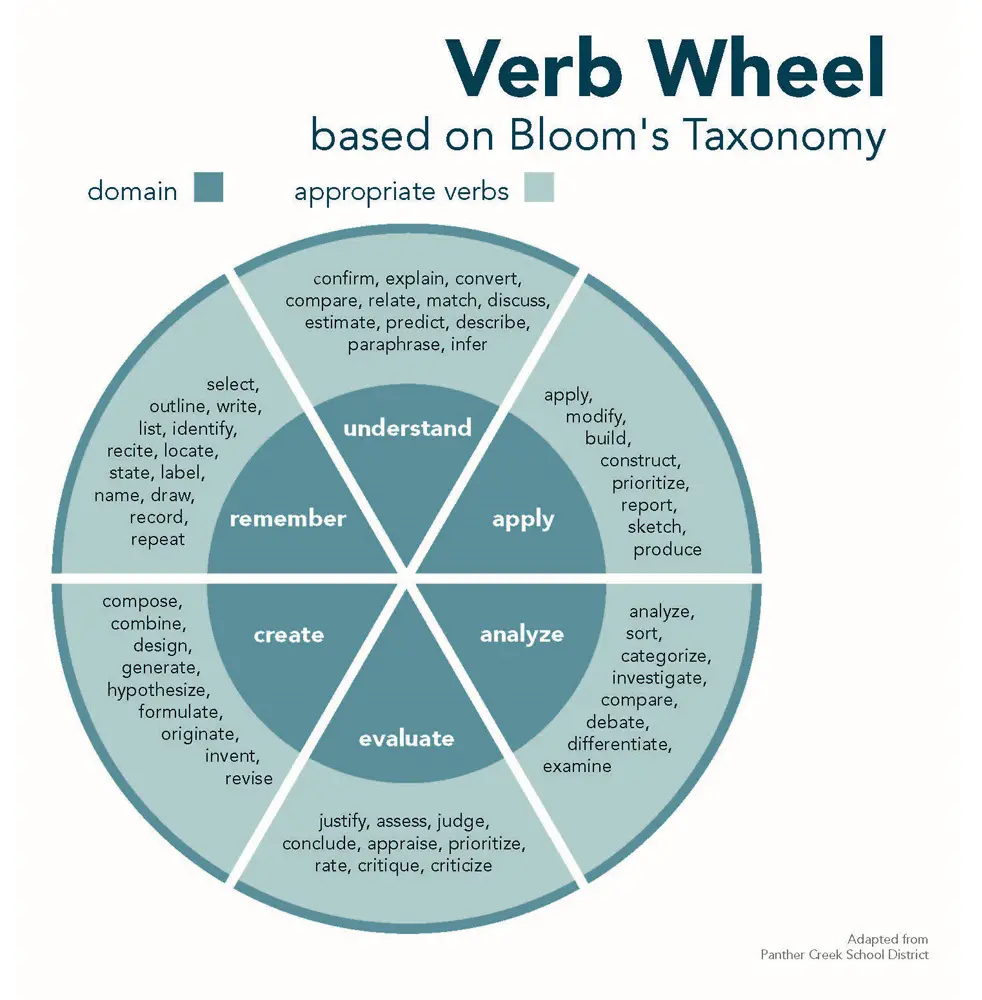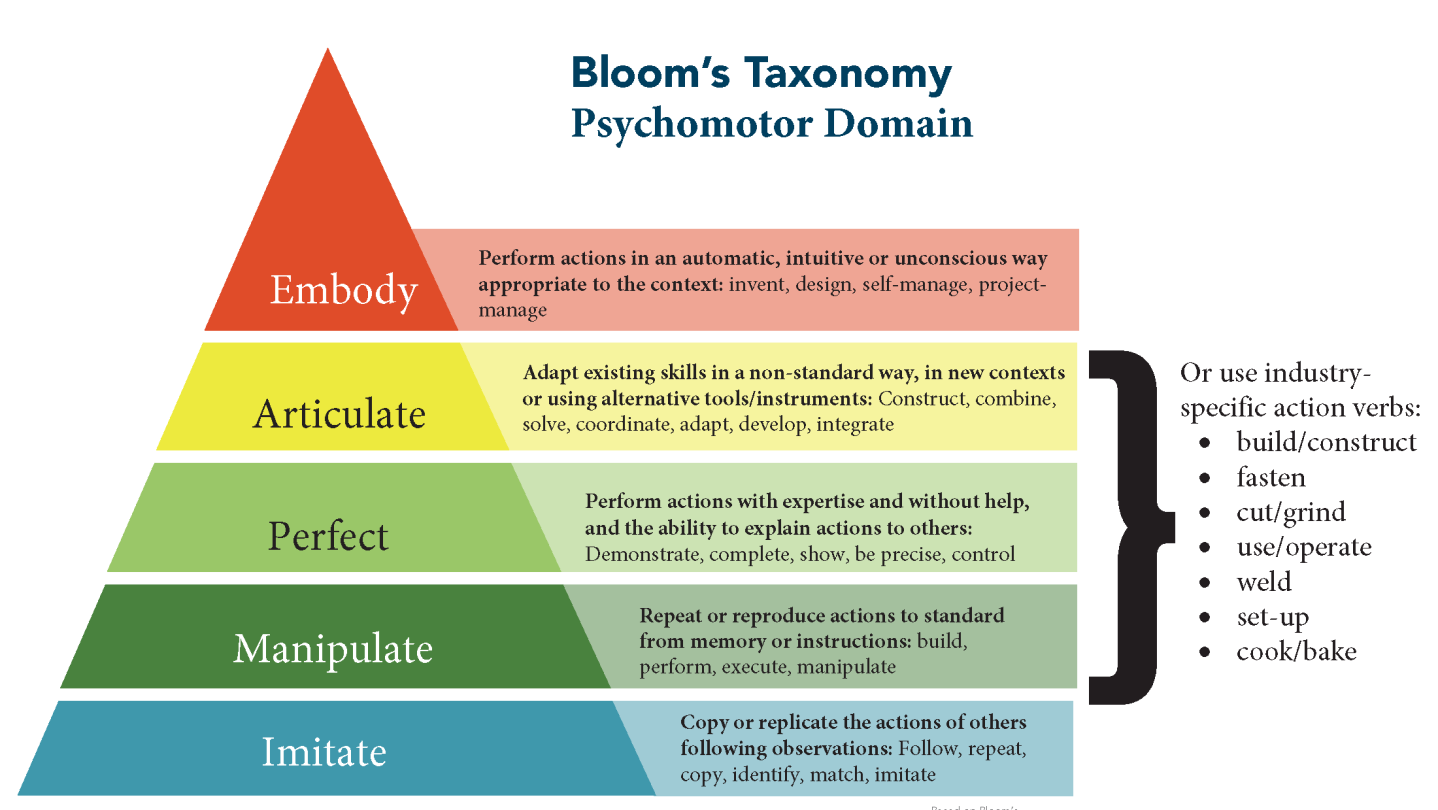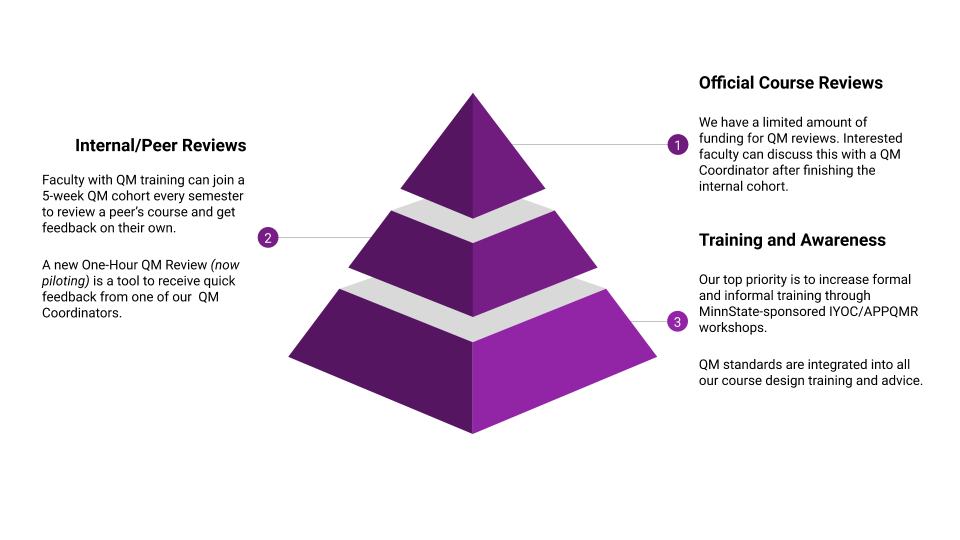Teaching and Learning

Course Design Basics
Congratulations, you’ve got a new class to teach! Now what?
A helpful way to approach course design is to start with the end in mind – sometimes called Backwards Course Design.
The end means the knowledge, skills, or abilities students will have mastered by the conclusion of the course. These are called course learning outcomes and are assigned by Saint Paul College. The rest is up to you to plan – how can you best use your time with them to help them reach their goals? How can you make sure all course components align with the goals?
We recommend breaking the course up into smaller chunks that are easier to manage. AEI also offers a course mapping template inspired by Quality Matters and Culturally Responsive Teaching techniques.
Why
Designing courses with the end in mind…
- prioritizes course learning outcomes over ‘nice to know’
- helps you stay organized and on track during the course
- allows for more formative feedback along the way
- is easier to adjust on the fly or make changes between semesters
How
- Find the official course learning outcomes on the Course Outline
- Devise assessments for each outcome (one assessment can cover multiple outcomes)
- Download the Course Mapping Template and break up the course into smaller chunks – called modules – that can be a week, a chapter, or a set of related topics
- Now that you have clear goals, what do they need to help them get there?
- Add activities that are engaging, interactive, culturally responsive, and give formative feedback
- Choose materials that are current, relevant, and culturally responsive
- Choose tech tools that help them reach the learning outcomes
Writing Learning Outcomes (LOs)
Learning outcomes are statements that capture the specific knowledge, skills or abilities that we intend students to learn from an activity, course, or program. They help us by providing measurable and focused targets for student learning. By starting with learning outcomes as endpoints, we can better design our instruction and programming to include relevant activities, materials and assessments that all align with the end goal.
Narrowing Down Course Learning Outcomes
A practical approach is to first brainstorm 5-10 things you want your students to be able to do as a result of your course, program, activity or service. Of those 5-10, try to identify the 3-6 things that are the most important. Having too many learning outcomes presents challenges in assessing all the outcomes, as well as using learning assessment data to make a reasonable number of improvements.
Anatomy of a Learning Outcome
A learning outcome contains one appropriate verb (an action) and an object(usually a noun).
- The appropriate verb refers to actions associated with the domain.
- The object describes the knowledge or ability students are expected to acquire or construct.
- It often begins with ‘Students will be able to’ or ‘Graduates will’, but you don’t need these words for course level outcomes.
In this model, based on the cognitive domain of Bloom’s Taxonomy, each section of the pie shows an example of a learning domain from ‘Remember’, the lowest, to ‘Create’, the highest, along with appropriate action verbs.
If you are creating learning outcomes in an applied trade or career field, you may also need to explore what Bloom called the ‘Psychomotor Domain’. The higher levels on this pyramid pair well with judge/evaluate/critique verbs in the cognitive domain.
For a program, you don’t always need to reach the ’embody’ level; set students up to master harder skills on the job. For a course, try to get up to ‘manipulate’ or ‘perfect’ level for specific skills, focusing on mastering foundational skills. Use rubrics with specific criteria to help measure a skill/action at different levels, breaking it down into parts.
Examples in Academic Affairs
- Students will be able to evaluate the credibility of a source.
- Students will be able to design a database for Human Resources use.
- Students will be able to construct a door frame according to industry standards
Examples in Student Affairs
- Students will be able to identify resources for professional networking.
- Students will be able to reflect on thepersonal and social implications of their behavior.


Refining your Learning Outcome
It is not uncommon when creating Learning Outcomes to draft initial statements that could benefit from some revisions. Making them concise, specific and measurable can be challenging. Here are a few approaches to help with revising your outcomes, along with examples of outcomes that could benefit from revisions:
- Avoid multiple verbs and objects – choose the verb that matches the highest level of learning that students can reasonably be expected to achieve in the course/program/activity/service.
- Avoid using ‘understand’ or ‘demonstrate knowledge of’ as verbs – they are not measurable.
- Use clear and learner-friendly language that students or the general public can understand.
Assessing Learning Outcomes (LOs)
Once the Learning Outcomes are written, you can start to think about how to assess them. Every outcome should be assessed in some way to measure student learning, give feedback and make improvements. The assessment method should be appropriate to the learning outcome and level.
Efficient and effective assessments result in usable data that can inform improvement of student learning. A few examples include essays, final exams, practical demonstrations, observations, projects or surveys.
Alignment
When choosing an assessment, it’s important to match it to the verb used in the learning outcome. Bloom’s Taxonomy of learning tells you what type of activity will demonstrate the knowledge, skill, or ability you want to measure. A good assessment is appropriate for the verb.
A lower level verb like recall or identify can be measured with a simple assessment.
A higher level verb such as apply or reflect will require a more robust assessment.
Performance skills are generally measured through practical exams or direct observation.
Formative and Summative Assessments
Formative Assessments give timely feedback on student performance to help them as the course/activity progresses. How can they improve going forward?
Summative Assessments come at the end of the learning course/activity to measure their achievement. Did they reach the goal(s) stated in the learning outcome(s)?
Direct and Indirect Assessments
Direct assessments involve looking at real samples of student work or performance to measure achievement of an outcome. Learning is observed, displayed or demonstrated.
Examples: Exams, quizzes, papers, direct observations, projects, performances, portfolios, presentations, clinicals, practicums, internships
Indirect assessments take information gathered in other ways. These often measure students’ opinions of their own learning. Learning is self-reported, described or perceived.
Examples: Surveys, self-reflections, journals, polls, focus groups, interviews
Although indirect measures are not as strong because they are self-reported, they add to the complete picture of student learning.
Using Assessment Data
The data collected in assessments are not only useful for students, but also provide priceless information about the learning experience itself. How can you improve this course/activity/program in the future? What parts of its design need attention? It could be the structure, materials (textbook), assessment (exam questions), or something else.
Quality Matters
Quality Matters is a nationally recognized standard for online/hybrid course design. It consists of a rubric with 42 standards, a set of training courses, and a peer-review process for official certification.

Online/Hybrid Course Certification
Quality Matters requires that you wait until a course is mature – run more than 2 times – before submitting for the QM peer review process. Once certified, it can carry the QM certification for 5 years unless there are major revisions, such as changes to the learning outcomes or the textbook.
Want to get an online/hybrid course certified? Don’t be intimidated! We are here to guide you through the process and help you prepare ahead of time.
Free Training & Preparation
Saint Paul College and Minnesota State both offer free training and support to any Full-Time or Part-Time faculty members who are interested in improving their courses using Quality Matters.
Applying the Quality Matters Rubric (APPQMR)
Learn about the QM rubric, applying its standards, and giving feedback in this FREE 2-week online workshop. You will gain a thorough understanding of evidence-based practices for online/hybrid course design.
Improving Your Online Course (IYOC)
Take one of your existing courses and apply 23 of the essential QM standards to it in this FREE 2-week online workshop. You will come away with an action plan for further improving your course.
Saint Paul College Internal Review Cohort
Work asynchronously over 5 weeks with other faculty and an Instructional Designer to assess your course’s readiness for the official QM peer review process. Usually offered once per semester, the cohort requires previous QM training/experience to participate.
Course Review Preparation Resources
Active Learning
Active learning gives students the opportunity to participate in activities that enhance their understanding of a subject matter rather than being passive recipients of knowledge.
Have Students interact with…
- Other students – have them work together through peer review, think-pair-share, discussion boards, or group projects
- Course content – allow students to engage directly with new material – readings, required videos, essays and other practice tools
- You! Provide ample feedback during the class and allow for questions and discussion
Build Community
- Especially when teaching online, spend time in the first few weeks for students to get to know one another
- Spend time interacting with students to build trust
- If you have larger group projects later on, start small early in the semester
- Have students work in pairs
- Break up larger projects into small pieces
- Introduce collaborative technology, like OneDrive, in early, low-stakes activities
Why
In Student Engagement Techniques: A Handbook for College Faculty, Elizabeth Barkley states that “the greater the student’s involvement or engagement in academic work or in the academic experience, the greater their level of knowledge acquisition and general cognitive development.”
Active learning encourages collaboration, promotes critical and creative thinking skills, and increases engagement. It can also be fun!
How
- Choose the active learning strategy, making sure it aligns with your intended learning outcomes:
- The K. Patricia Cross Academy’s free instructional videos and resource
- Berkeley’s Active Learning Designs
- Vanderbilt’s Active Learning Cheat Sheet
- Plan the activity and account for any logistical preparations
- Set aside plenty of time for instructing students and tell them how this activity supports their learning
- Evaluate how it went and adjust your plan going forward